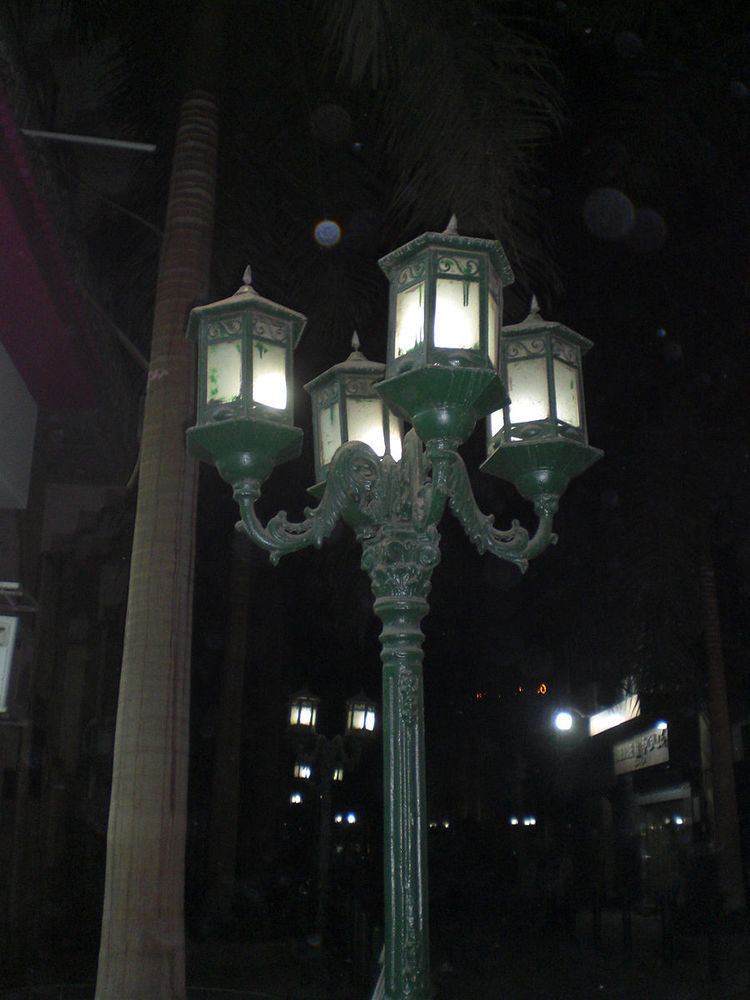 | ||
Qasr El Nil Street is a street in Downtown Cairo, Egypt. Qasr El Nil Street is one of the biggest streets in the downtown Cairo area with many businesses, restaurants, and an active nightlife.
Contents
- Geography
- Ismail Pasha and Ismailiya era
- British and independence eras
- Architecture
- Landmarks
- Present day
- References
The vintage urban planning and architecture here are reminiscent of the illustrious period of late 19th and early 20th century European Beaux-Arts and Egyptian—Islamic—Moorish Revival styles. The street and its new building designs were part of creating a new international downtown district, to link to Egypt’s rich Islamic heritage and institutions with the many new foreign enterprises, at the turn of the 20th century in Cairo.
Geography
Qasr El Nil Street extends (east to west): from the Abdeen Palace at Abdeen Square, passes a vibrant business district, Bab El-Lauq Market, and the American University in Cairo—Downtown Campus, is joined by Talaat Harb Street and passes through Tahrir Square with The Mogamma building and Egyptian Antiquities Museum, and then crosses the Nile River on the Qasr El Nil Bridge, to end on Gezira Island.
Isma'il Pasha and Ismailiya era
Isma'il Pasha, the ruler of Egypt, decided to strategically reclaim the East Bank of the Nile opposite Gezira Island, and create a 'Paris on the Nile.' The lower area was part of the Nile's natural pond, marsh, wetland, and riparian zone habitats for millennia, making this an ambitious civil engineering project. The existing 1880s Khairy Pasha palace was higher in the eastern Tahrir Square area, and later was absorbed into the American University in Cairo downtown campus. This urban project’s starting point was building the Egyptian Army Barracks, which became an important Egyptian and later British government institution. This area was eventually part of the urban district called 'Ismailiya' and 617 acres (2.50 km2) were allocated for this new neighborhood in which Qasr el Nil Street was centered. After adequate civic infrastructure was completed in 1874, Ismail Pasha decided that buildings had to cost a minimum 2000 L.E. amount of money to build and furnish. The large sum for the time was intended to ensure that the buildings in the Ismailiya district would be significant, large and built with expensive materials, and therefore excluding small shops and houses. Throughout its early years the street attracted many of the Egyptian elites, socialites, celebrities, and businesspeople, who caused a commercialization and development movement from the street beyond into the district that was rising to become classic downtown Cairo.
British and independence eras
When the British arrived to oversee Egypt in 1882, their first decision was to occupy the Egyptian Army Barracks on the Nile. Khedive Tawfiq disbanded the Egyptian Army five days later to humiliate the Egyptian officers who demonstrated against their own army. After many years of British occupation, King Farouk reclaimed the Barracks structures in 1948, but relocated the new Egyptian Army Barracks east to the Abbassia district. The site of the Egyptian Army Barracks was first then converted into a municipality building of Cairo (later the Nile Hilton site), changing central Qasr El Nil Street from a military to civilian character thereafter. The adjacent Midan Ismailiyya square, later renamed as Tahrir Square—Liberation Square, was expanded after some of the British barracks demolition 'liberated' space for Cairenes.
Architecture
Qasr El Nil Street's original architecture is reminiscent of European Beaux-Arts, Neo-Baroque, Art Nouveau, and Modernisme, and Art Deco architectural influences, with some Egyptian, Islamic, and Moorish Revival architectural styles, and recent modernist buildings as well.
Landmarks
Some of the landmarks on or near Qasr El Nil Street, from east to west, include:
The Abdeen Palace was built by Khedive Ismail in the 19th century to become the official government headquarters and royal residence, replacing the Citadel of Cairo used by rulers since the Middle Ages. Construction started in 1863 and continued for 10 years and the palace was officially inaugurated in 1874. The name means “Palace of the Nile” and refers to the name of the palace built by Said Pasha in 1858. The extensive gardens were completed in 1921 by Sultan Fuad I. The palace includes 500 rooms. Currently the upper floors (the former living quarters of the royal family) are reserved for visiting foreign dignitaries. The palace structure is a national museums centre: with the Silver Museum, the Arms Museum, the Royal Family Museum, the Presidential Gifts Museum, and the Historical Documents Museum.
Present day
Qasr El Nil Street today is part of the vibrant culture of downtown Cairo. There are a lot of clothing and shoe stores in addition to banks and travel agencies. "After 8" is a popular night club located on Qasr el Nil Street. There is also an ice cream and sweets store called Groppi’s that has been there since the turn of the century. The Qasr el Nil British Army Barracks were demolished in 1947 and replaced by an expanded Tahrir Square and the early 1950s modernist Nile Hilton Hotel complex.
In recent decades Qasr El Nil Street has become busier, and now there is insufficient parking for residents due to increasing commercial uses and number of 'nightlife venues' on the street especially, and in the neighborhood. A recent event here was the anti-Algerian riots that targeted an Algerian airline in the fallout of the events that took place during the World Cup qualification matches. The most recent street events are being a part of the 2011 Egyptian protest demonstrations for democracy, especially on the street's tw approaches to and section within Tahrir Square.
